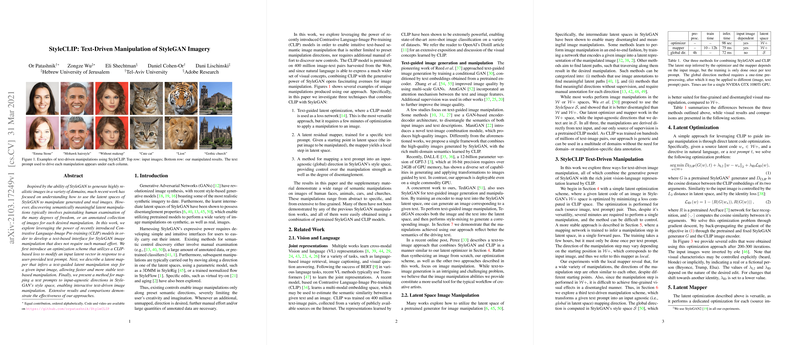Text-Driven Manipulation of StyleGAN Imagery Using CLIP
The paper "StyleCLIP: Text-Driven Manipulation of StyleGAN Imagery" introduces methodologies to enhance the manipulation of images generated by StyleGAN through leveraging the capabilities of CLIP (Contrastive Language-Image Pre-training). The authors present three approaches to integrate text-driven control into image manipulation tasks, which do not strain under the requirement for preset directions of manipulation or manual effort in uncovering new control mechanisms.
Overview
Generative Adversarial Networks (GANs), particularly StyleGAN, have shown tremendous progress in generating high-quality, realistic images across various domains. Manipulating these images through StyleGAN's latent space has been explored extensively. However, traditional methods often demand significant manual intervention or large annotated datasets to discover semantically meaningful directions in the latent space. This paper proposes methods that combine the pre-trained CLIP model with StyleGAN to enable text-driven manipulations with less manual overhead and broader semantic control.
Methodologies
The authors explore three main techniques:
- Text-Guided Latent Optimization:
- This technique involves optimizing an input latent vector using a CLIP-based loss that aligns the generated image with a textual prompt. Here, the optimization problem is formulated by using the CLIP loss to ensure the generated image's embedding is semantically close to the text prompt, complemented by an identity loss to maintain the image's identity. This method provides versatility but requires several minutes of optimization per image.
- Latent Mapper:
- A network is trained to infer a manipulation step in the latent space guided by a text prompt. This network is divided into three sub-networks corresponding to different levels of detail (coarse, medium, fine) in the generated image. The mapper offers faster and more stable manipulations compared to direct optimization, though each mapper needs training for specific text prompts. Results indicate high fidelity manipulations for semantic attributes like hairstyles and facial expressions.
- Global Directions:
- The authors propose an approach to compute a global manipulation direction in StyleGAN's style space, which is independent of input images. This method uses prompt engineering to generate a stable direction in the CLIP embedding space, which is then mapped to StyleGAN's latent space. This global direction allows for fine-grained, highly disentangled manipulations and provides control over the manipulation strength.
Experimental Results
The paper presents numerous qualitative results showcasing the effectiveness of their approaches on different domains like human faces, animals, and cars. The manipulation results span a variety of attributes from specific celebrity likenesses to general facial expressions and hairstyles. Moreover, the paper demonstrates that certain complex manipulations are better handled by the latent mapper, while simpler semantic edits are effectively managed by global directions.
Comparisons and Evaluations
Comparisons with traditional methods such as GANSpace, InterFaceGAN, and StyleFlow illustrate the superiority of the proposed techniques in maintaining the originality of non-target attributes while applying manipulations. It also demonstrates that the combination of StyleGAN and CLIP outperforms other methods like TediGAN in terms of semantic alignment with textual descriptions.
Implications
This research introduces a significant advancement in the domain of text-driven image manipulation. The ability to control StyleGAN-generated images through natural language paves the way for more intuitive and user-friendly interfaces in creative applications. Practically, this can benefit domains such as digital art, content creation, and graphic design. Theoretically, the integration of multimodal embeddings for visual and linguistic models exemplifies the power of cross-domain synergy in enhancing GAN-based image synthesis.
Future Directions
Future developments may extend these methodologies to other generative models beyond StyleGAN, allowing broader applicability across different types of media and content. Enhancing real-time manipulation capabilities and reducing computational requirements could also make these techniques more accessible for widespread use. Additionally, addressing the limitations in diverse visual datasets can foster more robust manipulation models.
In conclusion, this paper presents a novel integration of StyleGAN and CLIP, showcasing substantial flexibility and efficacy in text-driven image manipulation. Such advancements underscore the potential for natural language to serve as a powerful tool for guided image synthesis.
